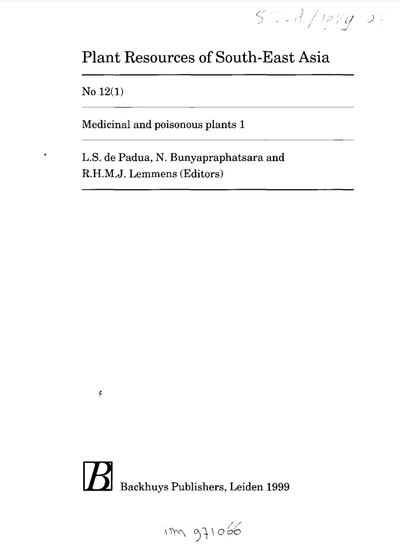Plant Resources of South-East Asia, No 13, Spices
C.C. de Guzman and J.S. Siemonsma (Editors)

Prosea volume 13 'Spices' focuses on the aromatic plants and their parts, fresh or dried, whole or ground, that are primarily used to impart flavour and fragrance to foods and drinks. The volume is closely related to Prosea volume 19 'Essential-oil plants' that deals with aromatic plants whose main use is for the extraction and use of essential oils.
Ample attention is given to the important and well-known spices from the Orient. No agricultural commodity has played a greater role in the history of 'East meeting West' than the oriental spices; more than any other commodity they are linked to the colonial history of South-East Asia. In addition the volume deals with the rich assortment of Mediterranean aromatic herbs that are increasingly being grown on a small scale in South-East Asia. Contrary to what happened in the South-East Asian vegetable sector, where a few introduced highland vegetables of temperate origin account for the bulk of the production, the temperate aromatic herbs are only slowly and very gradually being adopted in the region. This is surely related to the fact that the production and marketing of spices and their derivatives are very complex: the species involved are numerous but the economic significance of individual species is marginal.
This volume gives a balanced coverage of the information available on an important group of plant resources for South-East Asia. On the other hand, if the volume reflects the present state of knowledge, one can only conclude that the 'spices' form an ill-known commodity group, which has so far benefited little from the contributions of crop science. Perhaps this will change under the influence of the growing demand for natural and organic products geared towards wholesome living, and the increasing clamour to dispense with synthetic flavours and artificial food colouring.
Like all Prosea publications, this volume is the result of the efforts of an international team of scientists, supported by the Prosea network. The network of Country Offices in South-East Asia played an important role in tracing potential authors, in collecting and checking vernacular names, in compiling national statistics on areas and production, and in scanning local literature that may not be internationally known. It is impressive to see how much cooperation this approach could muster.
Publication Details
- Published: 1999
- Publisher: Backhuys Publishers, Leiden